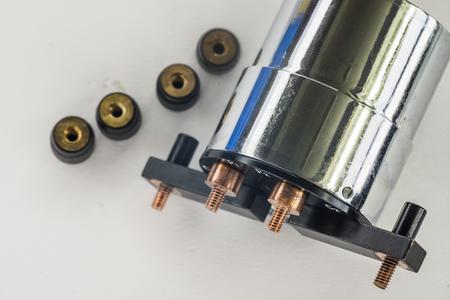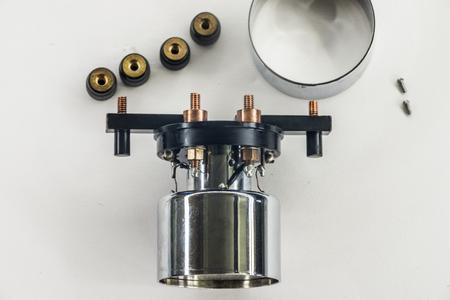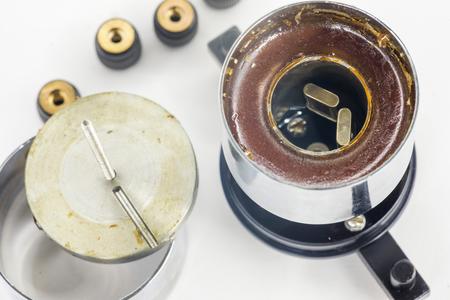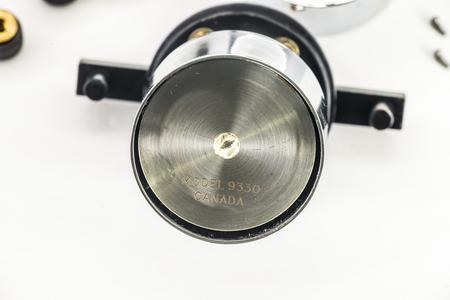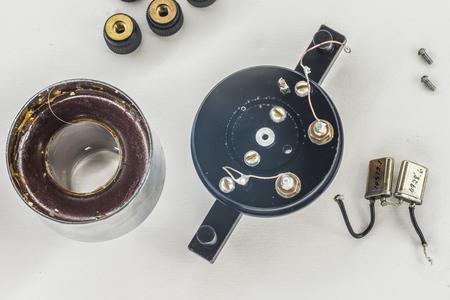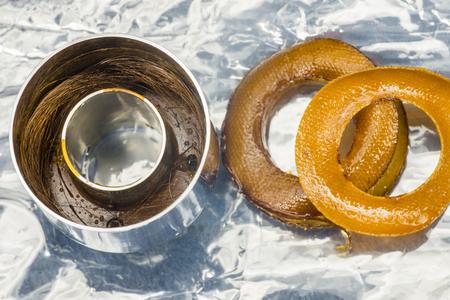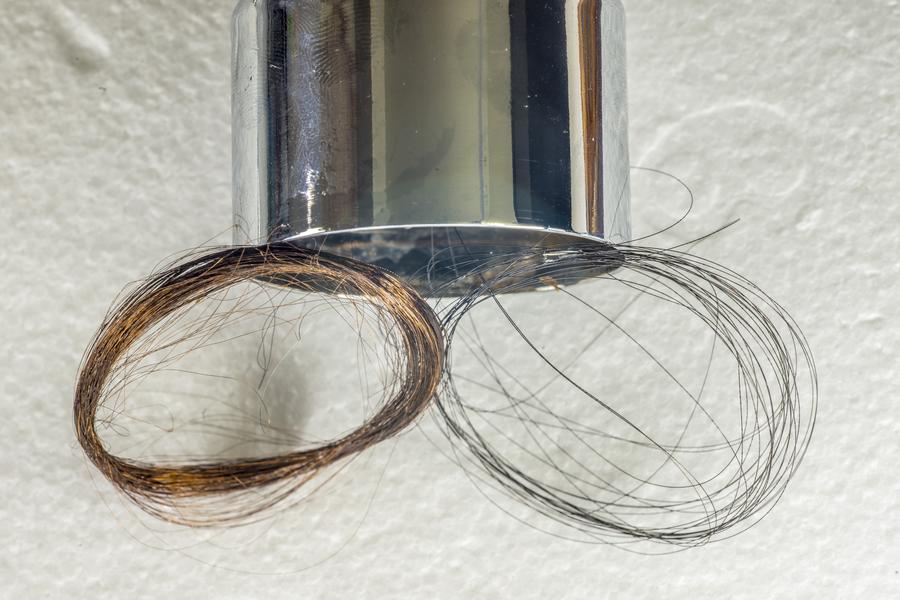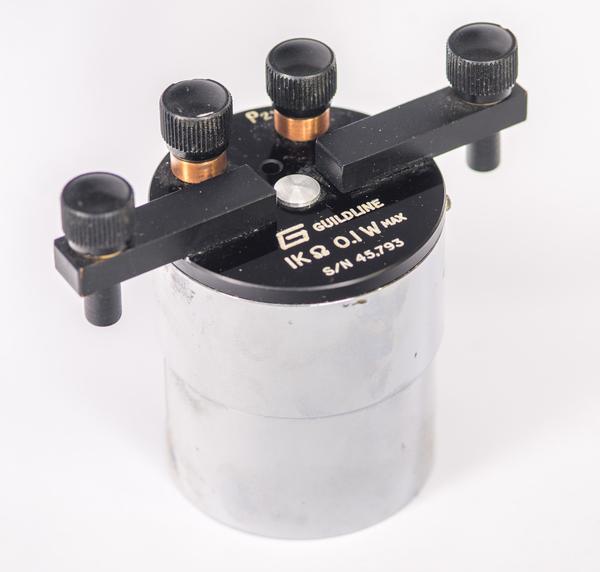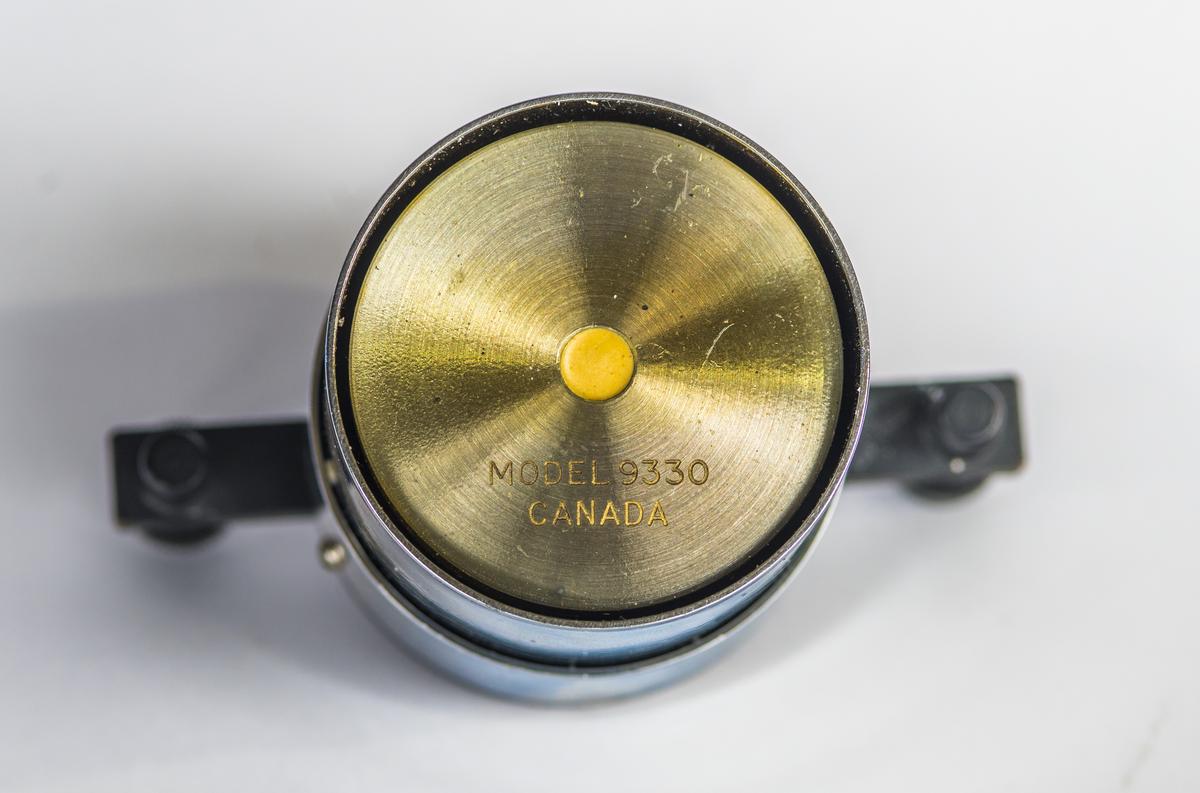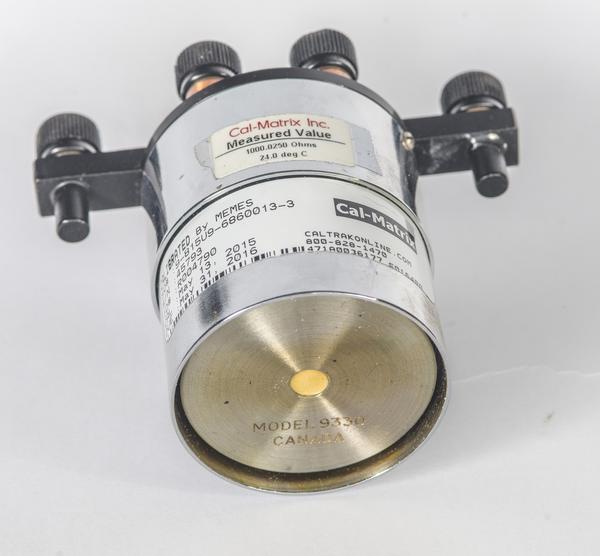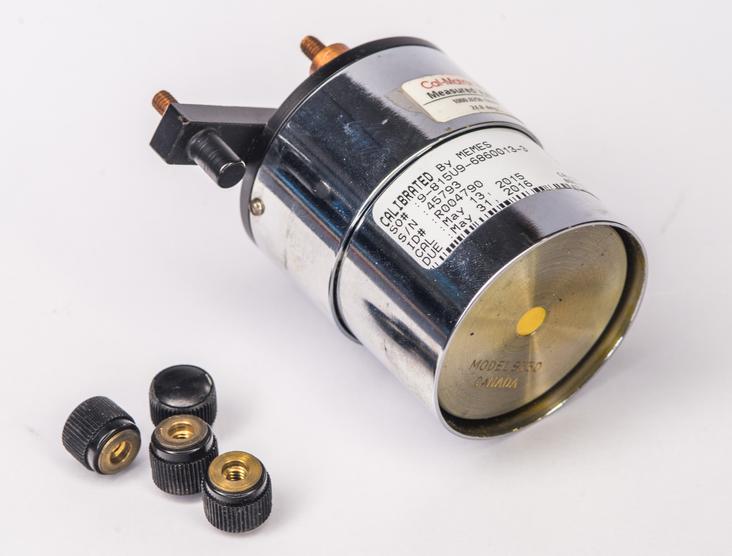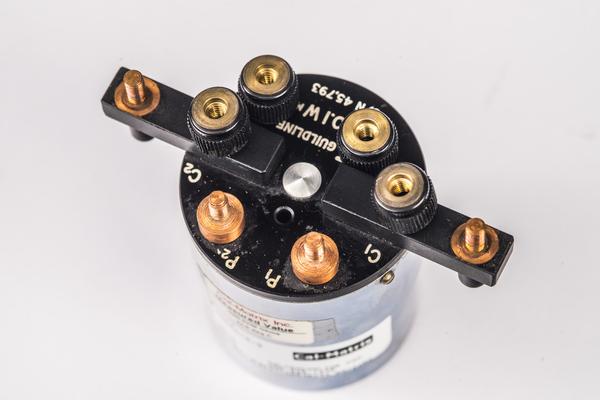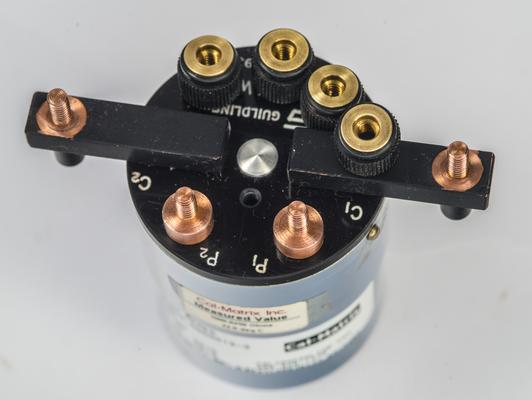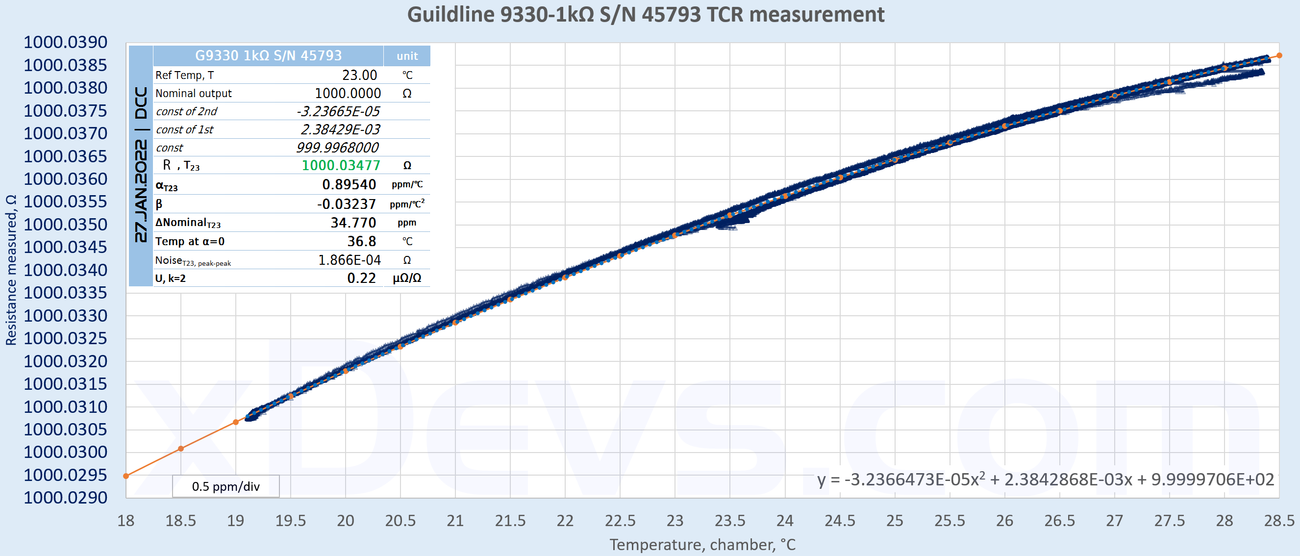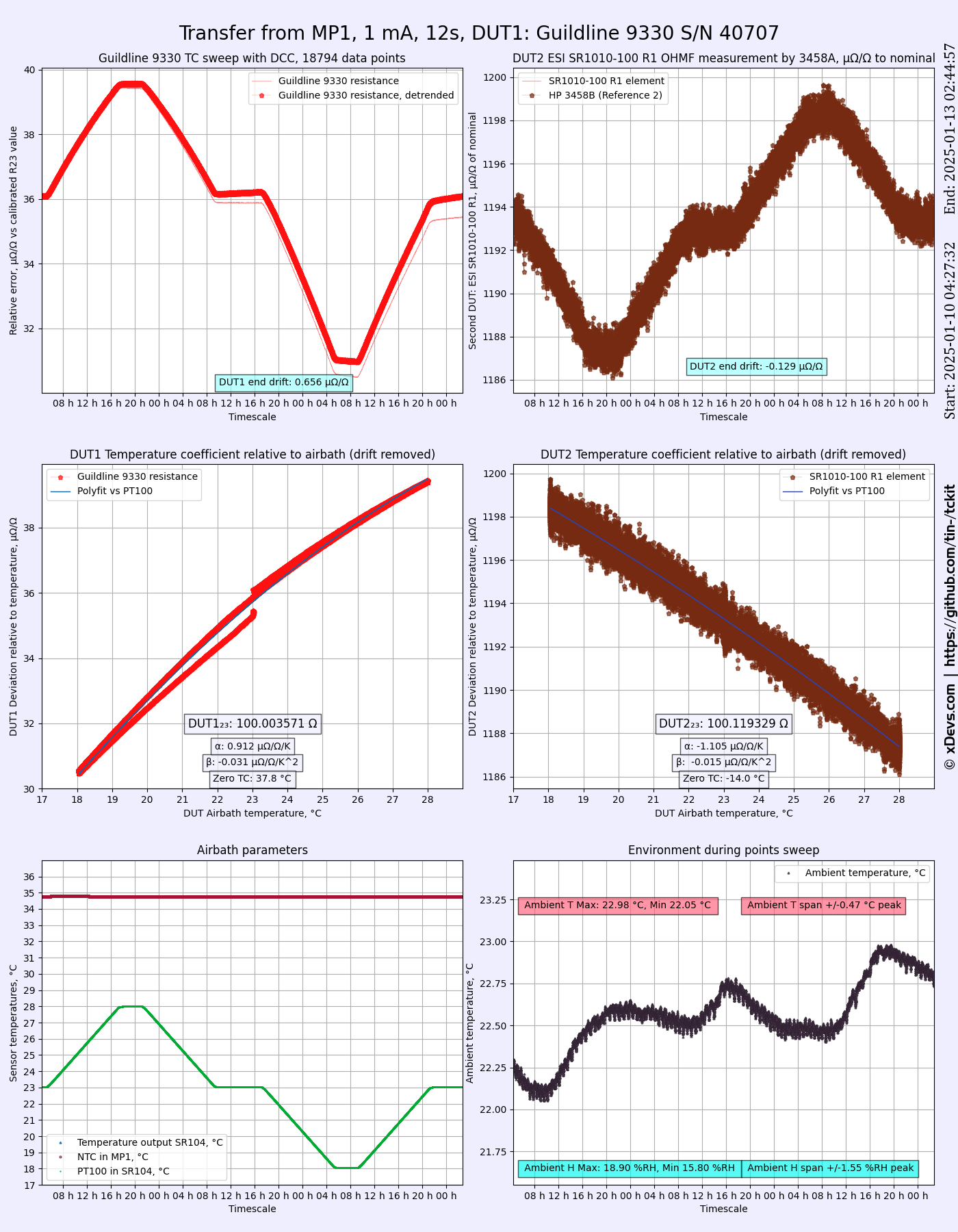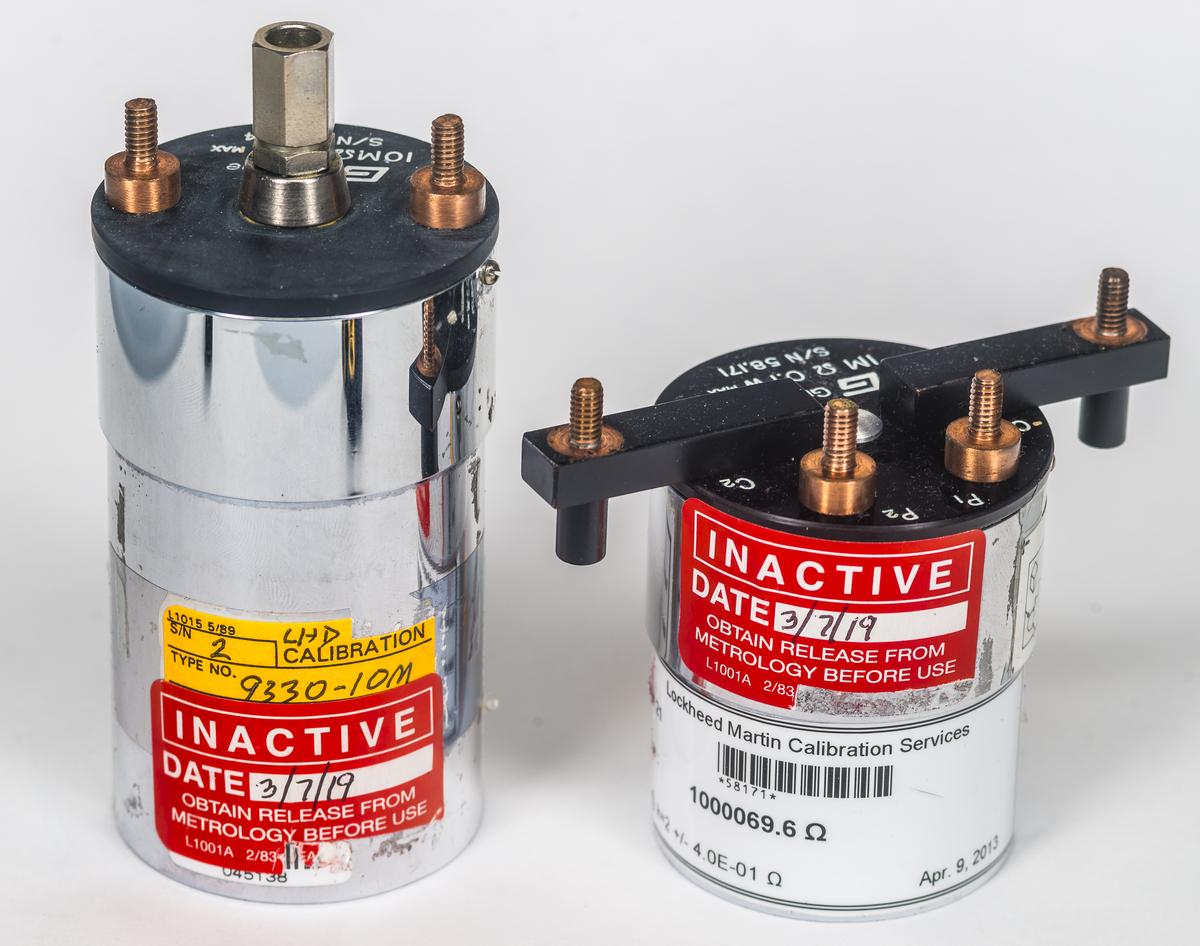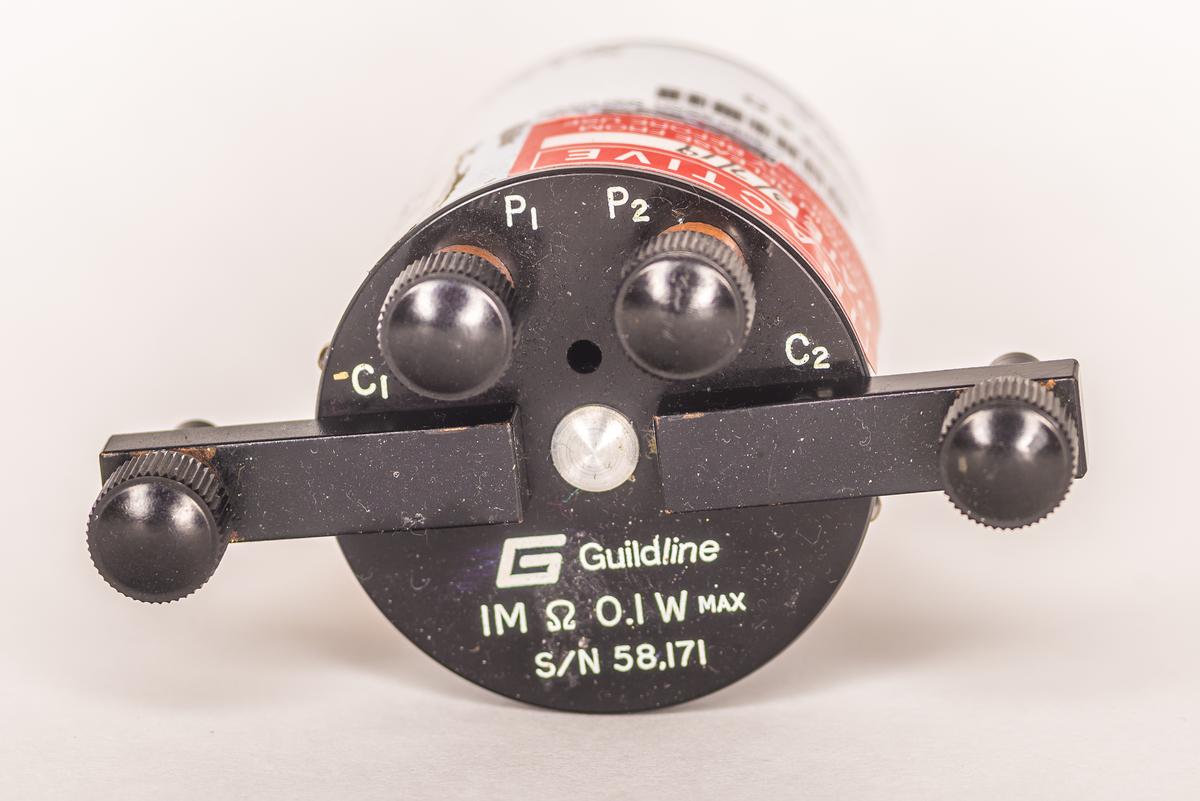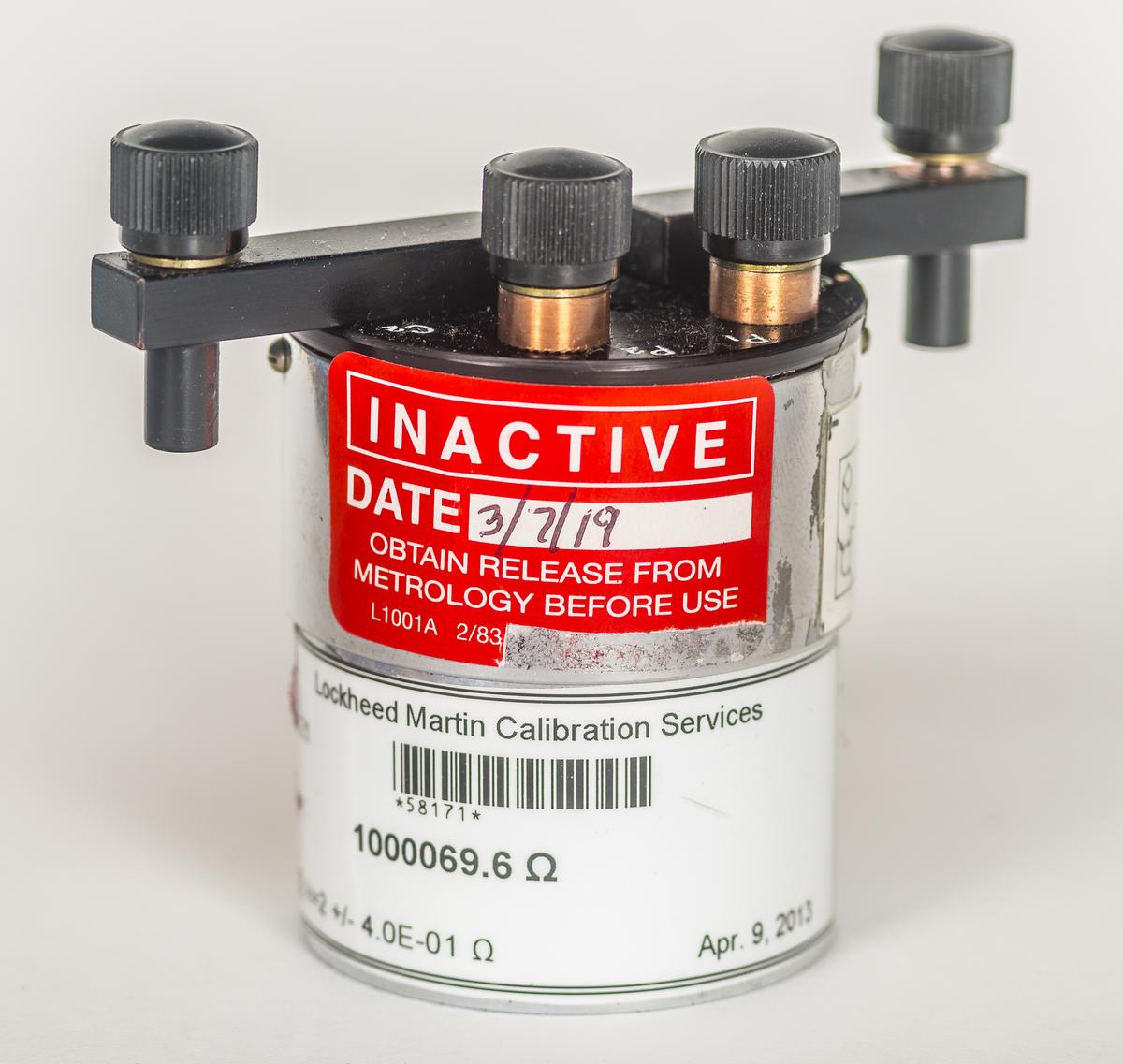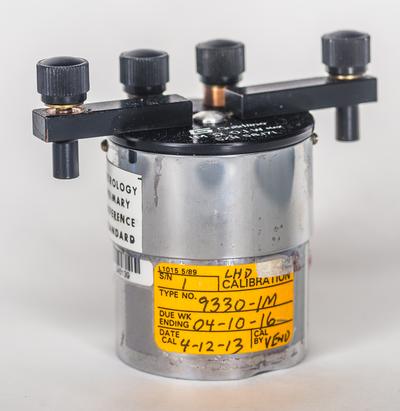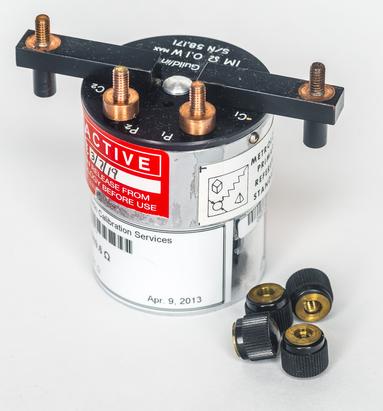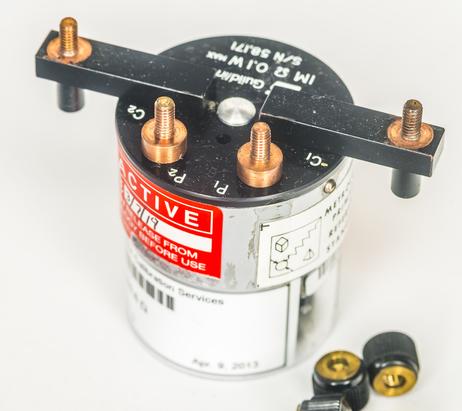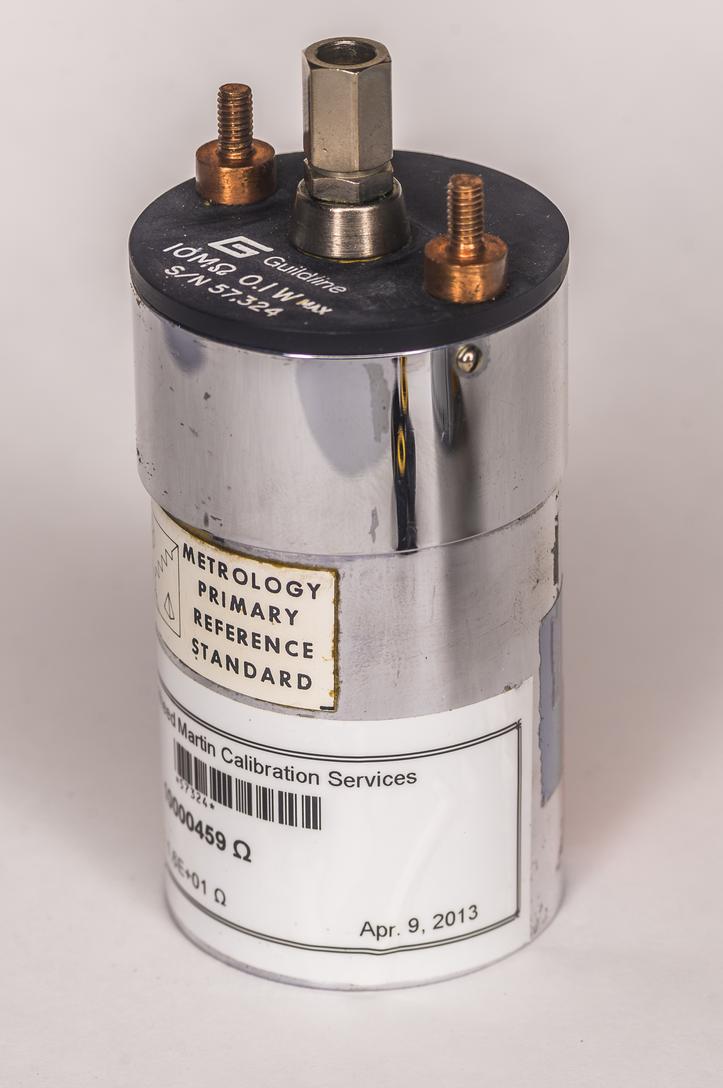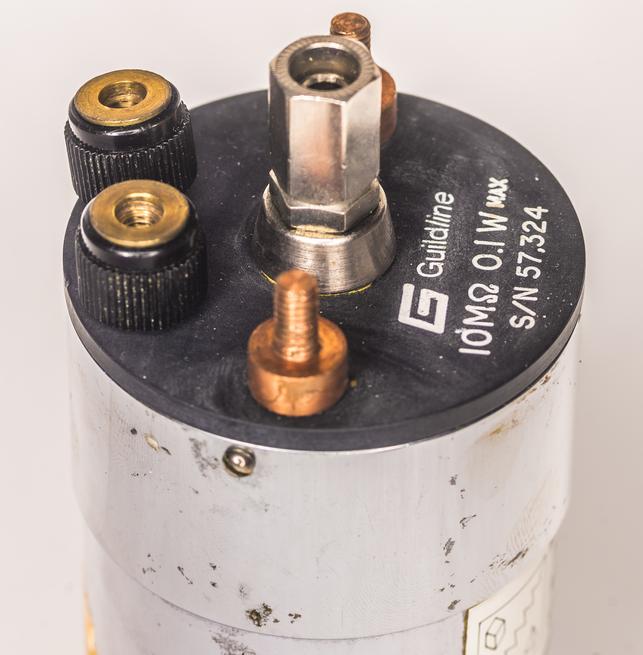- Guildline 9330 Specifications
- Exterior
- Internal construction
- Testing and disassembly of 100 KΩ resistor, S/N 40959
- Testing 1000 Ω resistor, S/N 45793
- Testing 100 Ω resistor, S/N 40707
- Testing NLab resistor set
Intro
Just recently we got pair of standard resistors to evaluate and likely repair, manufactured by Guildline Instruments.
Guildline Instruments is known supplier of precision gear, such as resistance, temperature measurement/control instruments and resistance standards. They are one of few, who has been in instrumentation business from 60’s (i.e. since 1957) and has lot of knowledge in the field of electrical metrology.
Two units we will look at today are 9330 series resistors, designed for oil bath operation, with 100 Ω and 100 KΩ resistance values.
Guildline 9330 Specifications
- Stability <3.5 ppm per year.
- Low thermal EMF design with copper terminals
- Nominal Accuracy to <2.5 ppm
- Report of Calibration traceable to NIST or NRCC included
- Available from 0.1 Ω through 100MΩ in decade values
- 4-terminal design up to 1MΩ
- Special values available on request
- Temperature Coefficient <2 ppm/K
- Hermetically sealed in oil
- Designed for use in temperature controlled oil baths
- Operating Range +18°C to +40°C
Standard lineup specification table from datasheet:
| Model | Nominal resistance, Ω | Nominal initial tolerance (±ppm) | Calibration uncertainty (± ppm) | Stability 6 month (±ppm) | Stability 1 year (±ppm) | TCR (<±ppm/K) | Maximum current (mA) | Maximum voltage (V) |
| 9330-0.1 | 0.1Ω | 5 | 1.5 | 3 | 5 | 3 | 1000 | 0.1 |
| 9330-1 | 1Ω | 2.5 | 1 | 2.5 | 3.5 | 2 | 320 | 0.32 |
| 9330-10 | 10Ω | 2.5 | 1 | 2.5 | 3.5 | 2 | 100 | 1 |
| 9330-25 | 25Ω | 2.5 | 1 | 2.5 | 3.5 | 2 | 64 | 1.6 |
| 9330-100 | 100Ω | 2.5 | 1 | 2.5 | 3.5 | 2 | 32 | 3.2 |
| 9330-1K | 1KΩ | 2.5 | 1 | 2.5 | 3.5 | 2 | 10 | 10 |
| 9330-10K | 10KΩ | 2.5 | 1 | 2.5 | 3.5 | 2 | 3.2 | 32 |
| 9330-100K | 100KΩ | 3 | 3 | 4 | 8 | 2 | 1 | 100 |
| 9330-1M | 1MΩ | 8 | 7 | 10 | 15 | 5 | 0.32 | 320 |
| 9330-10M | 10MΩ | 15 | 15 | 15 | 20 | 5 | 0.1 | 1000 |
| 9330-100M | 100MΩ | 30 | 25 | 20 | 30 | 5 | 0.01 | 1000 |
Guildline 9330 Standard resistor datasheet
Exterior
100 Ω resistor is functional and fine, while 100KΩ one reading is unstable, and jumps from 99.0K to 101.0K, randomly up and down. It’s obviously faulty and require repair. I’ll use this chance to tear unit apart and study internal construction, so we can see if it’s repairable.
Resistor is very compact, compared to most of similar type resistors from other vendors, as design tuned for oil-bath operation, where smaller mass and size allow quicker reach of temperature equilibrium and better control. As almost all standard resistors, 9330 featuring separate sense and source terminals, leveraging 4-wire Kelvin resistance measurement connection.
Internal construction
After removing two screws outer protection metal cylinder removed, revealing internal terminal connections with bare copper wire. Black insulated wires going to compensation resistor, while bare copper connect to glass isolated terminal studs in resistor element of inner cylinder.
Bottom part is covered by cap with threaded stud and easily removable by removing epoxy and using flat-head screwdriver. This reveals two canned compensation resistors, hanging in the center of inner area.
These two resistors have handwritten marking 14572.1 and 4928.6, which is likely their resistance value.
At first glance it look like hermetic epoxy seal, but it’s actually just a resin cap, with few oily sealant o-rings. I think good unit have oil filled inside, with cap preventing it leaking out, but on our broken resistor there was no oil left, only minor residues.
After resin removed, resistive EVANΩ(R) or Manganin wired elements were revealed. Shiny yellow coil with thinner wire is 99x KΩ element, and smaller dark wire coil is 1.1K&Omega element.
I did not expect to see resistance wire just a coil dumped in cavity. No support bobbin, no expected bifilar winding, and it’s not exactly hermetic either, as that resin ring seem not capable to provide hermetic-grade seal.
Schematics of resistor shown below:
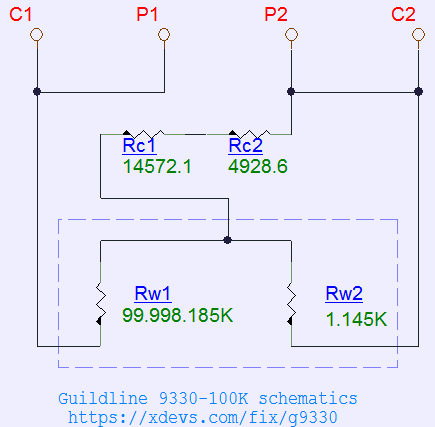
Testing and repair of 100 KΩ resistor
After alcohol bath and thorough cleaning of all parts, resistance values were measured, using HP 3458A in 4W-mode and NPLC200, with OCOMP enabled. I used copper twisted Cat6 cable for all connections.
| Resistor | Measured value | Measured tempco | Control measurement K2001 |
| RC1 | 14573.0177 Ω | Ω | |
| RC2 | 4929.0032 Ω | Ω | |
| RW1 | 98936.992 Ω | Ω | |
| RW2 | 1119.494256 Ω | Ω |
Obviosuly, 99K element is broken, not stable. Not much we can do here but to replace resistance wire for 99K section, and retune other resistances to match for 100 KΩ. It sounds easy task, but I have no stock for Evanohm or Manganin wire to do so.
Instead of this, I used Guildline 9330 frame and installed Vishay PG foil 10 KΩ resistor instead, to make it rugged 10 KΩ resistor standard. It’s suitable for calibration purposes for 3458A’s, which require 10KΩ standard for external cal.
Testing of 1000 Ω resistor, S/N 45793
This resistor was acquired from second-hand market. There was no known history other than calibration sticker label on resistor body from Cal-Matrix Metrology, Inc. which does not seem to have a web-site but located in Burlington, ON, Canada. Last known value from sticker is 1000.0250 Ω measured at somewhat strange +24.0 °C with unknown uncertainty.
Resistor arrived in decent shape without any damages, just slightly dirty. There was no oil residues that could suggest use in bath.
Other than already mentioned value and calibration date May 13, 2015 there is no much other useful information from the stickers.
So we will start measurements on this resistance standard and collect history starting from clean slate. Before that can happen binding posts and brass nuts were carefully cleaned with soft abrasive cloth and cleaned with 99% IPA.
Resistor then was connected to measurement setup with Measurements International 6010B DCC bridge to perform performance tests.
RAW Datalogs and results for 1000 Ω Guildline 9330, S/N 45793
For the initial measurements at xDevs Lab in January 2022 this unknown resistor was placed in an air bath at nominal 23.0 °C ±0.1 °C. For better accuracy DUT temperature was measured with separate Omega capsule RTD and Fluke 1529 thermometer readout. This RTD was installed inside Guildline 9330 thermal well. The average temperature of the resistor was measured to be 22.992 °C and uncertainty of this measurement estimated ±0.18 °C. Standard resistor used in first test was thermally stabilized Fluke 935-10kΩ S/N 001, placed in lab ambient environment. Fluke 935 was running on battery during the measurement period.
Ratio between Fluke SL935-10k (316 µA) and MM Guildline 9330-1k (3.16 mA)
Ratio between Fluke SL935-10k (316 µA) and MM Guildline 9330-1k (3.16 mA) in reverse
Ratio between xDevs.com’s ESI SR104 (316 µA) and MM Guildline 9330-1k (3.16 mA)
Ratio between T2 ESI SR104 (316 µA) and MM Guildline 9330-1k (3.16 mA)
Ratio between Fluke 5720A/H1 9999.9769 Ω (316 µA) and MM Guildline 9330-1k (3.16 mA)
Uncertainty and transfer analysis with Sandia PSL’s open-source toolkit
| Run, date | Rx | Ix | Rs | Is | Reversal time | Result | SDEV, ppm | ppm from average | Deviation from sticker |
|---|---|---|---|---|---|---|---|---|---|
| FSL935 FWD, JAN.9.2022 | 9999.9757 Ω ±0.3 ppm | 0.316 mA | G9330-1k | 3.16 mA | 20 s | 1000.03476 Ω | ±0.04 | +0.06 ppm | +9.76 ppm |
| SR104 forward, JAN.10.2022 | 10000.00128 Ω ±0.13 ppm | 0.316 mA | G9330-1k | 3.16 mA | 20 s | 1000.03477 Ω | ±0.03 | +0.07 ppm | +9.77 ppm |
| SR104 T2, JAN.12.2022 | 10000.0013 Ω ±0.13 ppm | 0.316 mA | G9330-1k | 3.16 mA | 20 s | 1000.03463 Ω | ±0.04 | -0.07 ppm | +9.63 ppm |
| Averaged | N/A | 0.316 mA | 1000.03470 Ω ±0.18 ppm | +9.72 ppm | |||||
| Corrected JAN.27.2022 | N/A | 0.316 mA | 1000.03477 Ω ±0.22 ppm | +9.77 ppm |
Temperature coefficient was also measured using two active Peltier air bath chambers.
Tempco measurement sequence data page with timescale plot
Based on these measurements we can estimate long-term drift of this resistance standard. To do so, one can take previous known calibration value from date May 13, 2015 which was 1000.0250 Ω with unknown uncertainty. That was 2452 days from today, 27.JAN.2022. Today measured value is 1000.03477 Ω with uncertainty ±0.22 ppm (95%).
Deviation between two values = ( (1000.03477 Ω / 1000.0250 Ω) – 1 ) * 1e6 = 9.77 ppm of change.
Making assumption of linear steady drift (which may not be true, but we don’t have anything else to work with just two points history) we can calculate daily drift = 9.77 ppm / 2452 days equals 0.003985 ppm/day.
By multiplying this into 1 year = 0.003985 * 365 days = 1.454 ppm/year. This is still well within Guildline 9330 specification of ±3.5 ppm/year.
Testing of 100 Ω resistor, S/N 40707
Ratio between Guildline 9330-1kΩ S/N 45793 and xDevs.com Guildline 9330-100
| Run, date | Rx | Ix | Rs | Is | Reversal time | Result | SDEV, ppm |
|---|---|---|---|---|---|---|---|
| XG9330-100, 10.MAR.2023 | 100.003437 Ω | 10 mA | RWS103 | 1 mA | 20 s | 100.003437 Ω ±0.3 ppm | ±0.1 ppm |
| XG9330-100, 3.AUG.2024 | 100.003929 Ω | 10 mA | MP1-1k | 1 mA | 8 s | 100.003929 Ω ±0.3 ppm | ±0.05 ppm |
| XG9330-100, 13.JAN.2025 | 100.003571 Ω | 10 mA | MP1-1k | 1 mA | 12 s | 100.003571 Ω ±0.3 ppm | ±0.1 ppm |
Tempco measurement was also performed with 70 hour sweep between +18 °C and +28 °C. This experiment generated DSV-file with raw data points. Measurement was performed on two DUTs in same chamber, Guildline 9330 with Measurements International 6010B DCC bridge and ESI SR1010-100 R1 measured by separate Keysight 3458A. Analysis of the data was done with help of Python script linked below.
Plot/analytics script for Python 3 / matplotlib
Necessary configuration file with some parameters
Script generated a set of charts, showcasing the performance and key parameters such as alpha/beta temperature coefficients on both DUTs, linear trend/hysteresis after temperature cycling experiment and absolute value calculated for +23.0 °C point. Uncertainty of this calibration was estimated at about 0.8 µΩ/Ω. Click on the image for higher resolution plot.
Various other tools used as well in prior tests:
Uncertainty and transfer analysis with Sandia PSL’s open-source toolkit
Tempco measurement sequence data page with timescale plot
Ratio between RWS103 999.96487 Ω (3.16 mA) and Guildline 9330-100
NLab Guildline 9330 standards set
Friendly lab has next set of Guildline 9330 resistance standards.
| Model | Serial Number | Measured, Ω | Measured Date | Measured temperature | Nominal resistance, Ω | Nominal initial tolerance (±ppm) | Factory uncertainty (± ppm) | Stability 6 month (±ppm) | Stability 1 year (±ppm) | TCR (<±ppm/K) | Maximum current (mA) | Maximum voltage (V) |
| 9330-10 | 59827 | 10.0003943 ±0.3 ppm | 18.DEC.2021 | +23.0 °C | 10Ω | 2.5 | 1 | 2.5 | 3.5 | 2 | 100 | 1 |
| 9330-25 | 61139 | ? | DEC.2021 | +23.0 °C | 25Ω | 2.5 | 1 | 2.5 | 3.5 | 2 | 64 | 1.6 |
| 9330-50 | 61140 | 50.001208 ±0.6 ppm | 19.DEC.2021 | +23.0 °C | 50Ω | 2.5 | 1 | 2.5 | 3.5 | 2 | 50 | 2.5 |
| 9330-100 | 59954 | 100.001827 ±0.3 ppm | 20.DEC.2021 | +23.0 °C | 100Ω | 2.5 | 1 | 2.5 | 3.5 | 2 | 32 | 3.2 |
| 9330-1K | 59120 | ? | +23.0 °C | 1KΩ | 2.5 | 1 | 2.5 | 3.5 | 2 | 10 | 10 |
More detailed look on each of them available below
Testing of 10 Ω resistor, S/N 59827
TBD.
Testing of 25 Ω resistor, S/N 61139
TBD.
Testing of 50 Ω resistor, S/N 61140
TBD.
Testing of 100 Ω resistor, S/N 59954
TBD.
Testing of 1000 Ω resistor, S/N 59120
TBD.
Testing 1 MΩ resistor, S/N 58171
Higher resistances were tested with help of MIL 6000A bridge bundled with Keysight 3458A 8½-digit DVM and custom 19.990 low noise source comprised of xDevs.com QVR module and Fluke 732B DC reference.
Posts were cleaned up mechanically down to shiny bare copper surfaces.
Measurements log:
| Run, date | Rx | Vx | Rs | Vs | Reversal time | Result | SDEV, ppm | ppm from average | Deviation from sticker |
|---|---|---|---|---|---|---|---|---|---|
| xDevs.com RWS-100k | 100006.470 Ω ±0.32 ppm | 9.09V, 0.826 mW | G9330-1M | 0.909 V | 20 s / 25 rdg | 1.00007851 MΩ ±0.46 ppm | ±0.06 ppm | +0.0 ppm | +8.909 ppm |
Testing 10 MΩ resistor, S/N 57324
This standard built differently to others 9330 series. It is much taller, has only two terminals instead of four because kelvin 4-wire connection does not matter anymore for 10 MΩ and higher resistances. Also thermal well hole in top casing was removed and shielding/guard 5-way binding post installed instead in center.
Top plastic cover cap also manufactured with different material, which has matt surfaces and leaves white residue if cleaned with 99% IPA. Perhaps it is changed to improve insulation properties of high-value resistance standards?
Condition of posts before cleaning:
Standard contacts and surfaces were cleaned mechanically and it was connected to MIL 6000A bridge system, with above mentioned Guildline 9330-1MΩ as reference.
Measurements log:
| Run, date | Rx | Vx | Rs | Vs | Reversal time | Result | SDEV, ppm | ppm from average | Deviation from sticker |
|---|---|---|---|---|---|---|---|---|---|
| G9330-1M | 1.00007851 Ω ±0.46 ppm | 18.17V, 0.033 mW | G9330-10M | 1.817 V, 3.3uW | 20 s / 20 rdg | 10.0006492 MΩ ±0.57 ppm | ±0.09 ppm | +0.0 ppm | +19.02 ppm |
Projects like this are born from passion and a desire to share how things work. Education is the foundation of a healthy society - especially important in today's volatile world. xDevs began as a personal project notepad in Kherson, Ukraine back in 2008 and has grown with support of passionate readers just like you. There are no (and never will be) any ads, sponsors or shareholders behind xDevs.com, just a commitment to inspire and help learning. If you are in a position to help others like us, please consider supporting xDevs.com’s home-country Ukraine in its defense of freedom to speak, freedom to live in peace and freedom to choose their way. You can use official site to support Ukraine – United24 or Help99. Every cent counts.
Modified: Jan. 16, 2025, 1:04 a.m.


